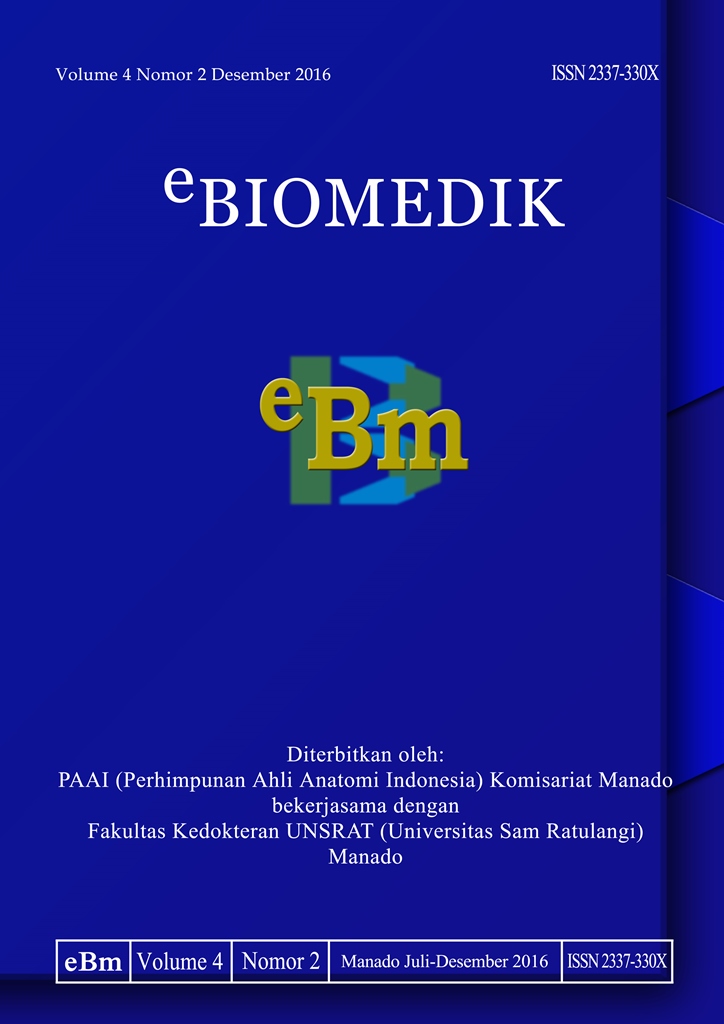GAMBARAN HISTOPATOLOGIK TESTIS TIKUS WISTAR (Rattus norvegicus) SETELAH PEMBERIAN MONOSODIUM GLUTAMATE (MSG)
DOI:
https://doi.org/10.35790/ebm.v4i2.14714Abstract
Abstract: Monosodium glutamate (MSG) is a sodium salt from glutamic acid which is currently very popular to be used as a food flavoring ingredient to stimulate appetite. The objective of the study to discover the histologic findings of wistar rats’ testicles after MSG administration. This was an experimental laboratoric study, using 20 wistar rats that has been divided into 4 groups. The negative control group is given standard pallet and drinking water for 40 days; it devided to 2 smaller groups, K1 and K2, each of the group was terminated on the 21st and 41st day. The intervention group was given MSG according to average consumption dose in Indonesia; it devided to two smaller groups, P1 and P2, each group was terminated on the 21st and 41st day. The result showed on group K1 and K2, a normal finding of seminiferous tubules, spermatogenic cell layer arrays, and interstitial cell density was found. On group P1, showed seminiferous tubules with decrease of spermatogenic cells development, causing the tubules compartment to appear vacant; the spermatogonia layers appeared sparse on basal membrane, and fewer interstitial cells. On group P2, the findings were not of much difference with group P1, but in this group, one testicle specimen showed calcification cells inside its seminiferous tubules was found. Conclusion: Administration of MSG according to average consumption dose in Indonesia causes decrease of seminiferous tubules’ diameter and decrease of the number of spermatogenic cells and interstitial cells.
Keywords: Monosodium glutamate (MSG), Indonesia average consumption dose, testicles.
Â
Abstrak: Monosodium glutamate (MSG) adalah garam natrium dari asam glutamat yang saat ini sangat popular digunakan sebagai bahan penyedap makanan untuk merangsang selera. Penelitian ini bertujuan untuk mengetahui gambaran histologik testis tikus wistar setelah pemberian MSG. Jenis penelitian ini ialah eksperimental laboratorik, menggunakan 20 ekor tikus wistar yang dibagi menjadi 4 kelompok. Kelompok kontrol negatif terdiri dari dua kelompok yakni K1 dan K2, masing-masing diterminasi pada hari ke-21 dan hari ke-41. Kelompok perlakuan diberi MSG sesuai dosis konsumsi rata-rata di Indonesia, terdiri dari dua kelompok yakni P1 dan P2, masing-masing diterminasi pada hari ke-21 dan hari ke-41. Hasil penelitian menunjukkan pada kelompok K1 dan K2 didapatkan gambaran tubulus semineferus, susunan lapisan sel spermatogenik dan kepadatan sel interstisial yang normal. Pada kelompok P1 didapatkan gambaran fokus-fokus tubulus semineferus tanpa perkembangan sel-sel spermatogenik sehingga ruang tubulus tampak kosong, lapisan spermatogonia yang saling jarang pada membran basalis, dan sedikit sel interstisial. Pada kelompok P2 didapatkan gambaran yang tak jauh berbeda dengan kelompok P1, namun pada kelompok ini didapatkan satu sediaan testis yang tampak ruang tubulus semineferusnya berisi sel-sel yang mengalami kalsifikasi. Simpulan: Pemberian MSG sesuai dosis konsumsi rata-rata di Indonesia menyebabkan mengecilnya diameter tubulus semineferus, penurunan jumlah lapisan sel-sel spermatogenik dan berkurangnya sel interstisial.
Kata Kunci: Monosodium glutamate (MSG), dosis rata-rata konsumsi Indonesia, testis.





